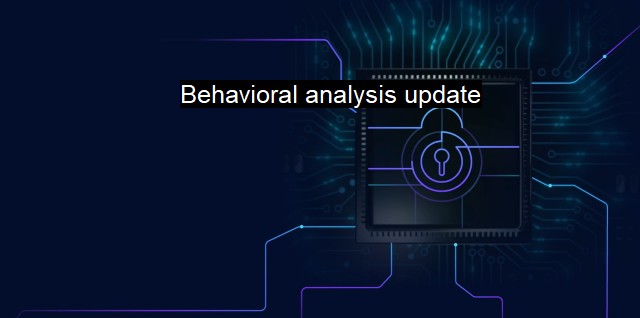What is Behavioral analysis update?
Enhancing Cybersecurity: The Significance of Behavioral Analysis alongside Antivirus Programs
Behavioral Analysis Update is a critical aspect of cybersecurity and plays a major role in antivirus software. Given the ever-evolving landscape of cyber threats, it is indispensable for every antivirus software to remain updated on the different kinds of cyber threats that are being discovered daily. Therefore, it is vital to continually update the behavioral analysis algorithms that are part of these antivirus packages, as this is the tool used to identify potentially malicious activity.Behavioral Analysis in cybersecurity is a method of detecting malware or other security threats by analyzing the behavior of files, applications and systems to look for suspicious activities. Traditional antivirus software operates by comparing a file's fingerprint against a database of known threats, also called signature-based detection. But nowadays, cyber threats have grown exponentially in both magnitude and sophistication, often changing their signatures to evade detection. Hence, signature-based detection is not enough, and the method has had to evolve.
This leads us to the importance of behavioral analysis. Unlike its signature-based counterpart, behavioral analysis doesn't rely solely on virus definitions. Instead, it observes the actions and behavior of applications. If it finds an application performing tasks commonly connected with malware— trying to modify the contents of another application's memory or attempting to access a restricted area of the operating system—it identifies it as potentially harmful and takes appropriate action.
Implementing behavioral analysis in antivirus software is a critical stage; keeping it updated or upgrading it constantly stands as an equally important stage. The method of detecting cyber threats grows and changes as rapidly as the threats themselves. Customizable rules and machine learning systems are engineered into regular updates, making them adaptable enough to not just recognize, but also predict new kinds of suspicious behaviors.
By adopting the evolving patterns of threat behavior in their updates, the behavioral algorithms can anticipate what properties or sequences of actions might constitute a possible attack, regardless of whether a human user identifies the threat or not. An up-to-date behavioral analysis system can rapidly adapt to zero-day attacks, polymorphic viruses, and Advanced Persistent Threats (APTs) that are increasingly common in the current digital landscape.
These updates are essential for any organization or individual who values the vitality and integrity of their data. When behavioral detection systems are kept updated, they fortify the cyber defense gate and the damage control measures the moment any unprecedented behavior is detected. The more current the algorithms analyzing behavior are, the faster they can quarantine the suspicious file, application, or activity even while it's being executed—or better yet, beforehand.
One of the key benefits of behavioral analysis updates is that they help to minimize false positives—alerts that wrongly identify good files as bad. By improving algorithms' recognition capacity, behavioral analysis updates can distinguish between legitimate software that behaves similarly to malware and genuine threats.
In a cyber landscape that never stops testing our resilience, constant behavioral analysis updates are the shield we need against sophisticated new forms of malware, which can sometimes slip by undetected through traditional, signature-based defenses. Therefore, ensuring security tools stay agile and adaptable establishes the line between susceptibility and safety in the fight against cyber threats. With continual and consistent updates, behavioral analysis—an already powerful threat detection tool—becomes an even more effective layer of protection for systems across the globe. besides fortifying the line of defense, behavioral analysis updates are essentially the policemen who direct us safely through the constantly developing maze of cybersecurity.

Behavioral analysis update FAQs
What is the behavioral analysis update in cybersecurity?
The behavioral analysis update in cybersecurity refers to the implementation of advanced techniques for analyzing the behavior of software and detecting potential threats based on abnormal activity patterns. This approach helps antivirus software to identify and block malware that may evade traditional signature-based detection methods.How does the behavioral analysis update improve antivirus software?
The behavioral analysis update improves antivirus software by allowing it to detect previously unknown malware that may have evaded signature-based detection. By analyzing the behavior of software and identifying unusual patterns, antivirus software can proactively prevent potential threats and protect against zero-day attacks.How does the behavioral analysis update affect system performance?
The behavioral analysis update can have an impact on system performance, as it requires more resources to analyze the behavior of software in real-time. However, modern antivirus software is designed to minimize this impact by using advanced algorithms and optimization techniques. Additionally, the benefits of enhanced threat detection and prevention outweigh any potential impact on system performance.Do all antivirus providers offer behavioral analysis updates?
Not all antivirus providers offer behavioral analysis updates, as it requires advanced technology and expertise in cybersecurity. However, many leading antivirus vendors offer this feature as part of their solutions, and it is becoming increasingly common as the threat landscape evolves. It is important to choose an antivirus provider that offers behavioral analysis updates to ensure maximum protection against advanced threats.| | A | | | B | | | C | | | D | | | E | | | F | | | G | | | H | | | I | | | J | | | K | | | L | | | M | |
| | N | | | O | | | P | | | Q | | | R | | | S | | | T | | | U | | | V | | | W | | | X | | | Y | | | Z | |
| | 1 | | | 2 | | | 3 | | | 4 | | | 7 | | | 8 | | |||||||